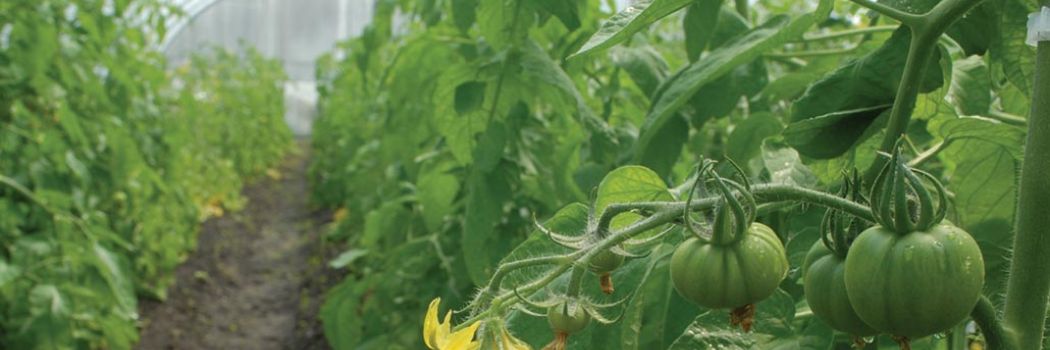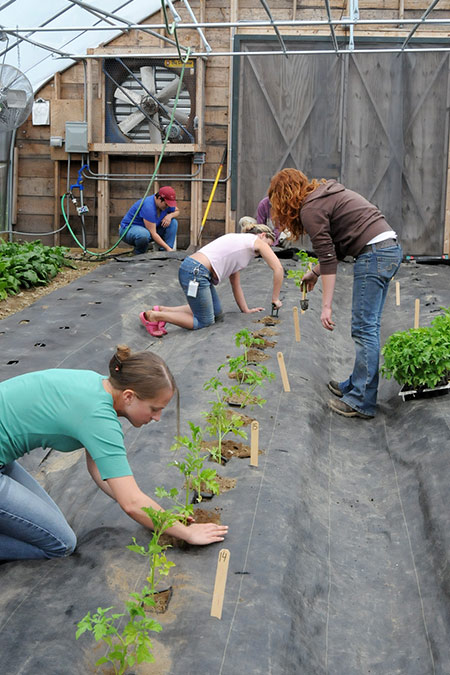- Video: 'Cherry Bomb' | JSS-Bred Organic Cherry x Grape Tomato from Johnny's
- Open-Pollinated Revival Project: 3 Improved OP Heirloom & Heritage Tomatoes
- 3 Ways to Choose the Best Tomato Varieties | Johnny's Selected Seeds
- Video: Tomato Pruning 101 • Tutorial with Niki Jabbour
- 'Unity' Red Beefsteak Tomato Variety from Johnny's
- Tomatoes: 10 Unsung Heroes | Johnny's Educational Webinar Resources
- Video: Tomatoes: 10 Unsung Heroes | Johnny's Webinar Series
- Video: High-Value Crops & Varieties for Your Garden • Tutorial with Niki Jabbour
- 10 Tips for Growing Heirloom Tomatoes
- Fundamentals of Tomato Grafting | Johnny's Educational Webinar Resources
- Video: How to Prune Greenhouse Tomatoes
- Video: How to Graft Greenhouse Tomatoes
- Video: Artisan Tomatoes™ | from Johnny's Selected Seeds
- Greenhouse Tomato Varieties | Comparison Chart (PDF)
- Video: How to Identify Late Blight on Tomatoes
- 'Honey Bee' and 'Queen Bee' Organic Cherry Tomatoes With Late Blight Resistance From Johnny's
- Tomato Innovation: Breeding & Trialing for Your Finest Harvest
- Video: Tomato Variety Trends: How Breeding Influences Your Seed Selection | Johnny's Webinar Series
- Top-Grafting Tomatoes | Advantages, Materials, Technique | Tech Sheet (PDF)
- 'Honey Bee' and 'Queen Bee' Organic Cherry Tomatoes With Late Blight Resistance From Johnny's
- Determinate Tomato Varieties | Comparison Chart (PDF)
- 'GinFiz' & 'Margold' Beefsteak Tomatoes for the Greenhouse
- Grafted Tomato Plants | Key Growing Information
- 'Maxifort' Rootstock Tomato Germination | Tech Sheet (PDF)
- Video: 'Clementine' | The Tangerine-Colored, Organic Cocktail Tomato from Johnny's Breeding Team
- Video: Growing Tomatoes in Containers with Niki Jabbour & Johnny's
- French Heritage Tomato Varieties | The Best of the Old World Marries the New
- Webinar Slide Deck | Fundamentals of Tomato Grafting | 15-pp PDF
- Grow a Rainbow Mix of Cherry Tomatoes
- Video: 'Mochi' : The Gumdrop-like Cherry Tomato | Exclusively from Johnny's
- Video: Choosing & Growing Paste Tomatoes for Sauce-Making • with Niki Jabbour
- Trellising & Crop Support Systems for Tomatoes | Stake & Basketweave, Stake & Hanging String/Wire, Lower & Lean
- Tomato Production Challenges & Issues | Tech Sheet (PDF)
- Greenhouse Tomatoes | Key Growing Information
- Video: How to Prune Tomatoes
- Greenhouse Tomato Pruning & String Trellising | Tech Sheet (PDF)
- Heirloom Tomato Varieties | Comparison Chart (PDF)
- Late-Summer Recipe Preview with Farmer-Chef Frank Giglio | Three Lily Farm, Thorndike, Maine
- Video: How to Grow Cherry Tomatoes • From Seed to Harvest
- Paste, Plum & Roma Tomato Varieties | Comparison Chart (PDF)
- Webinar Slide Deck | Tomato Variety Trends: How Breeding Influences Your Seed Selection | 29-pp PDF
- Video: An Intro to the Fundamentals of Tomato Grafting Success | Johnny's Webinar Series
- Side-Grafting Tomatoes | Advantages, Materials, Technique | Tech Sheet (PDF)
- Common Tomato Pests, Diseases & Physiological Disorders | An Overview of Biotic & Abiotic Problems
- 'Mimosa' — Organic Orange Grape Tomato Variety Developed By Johnny's
- Video: How We Process Our 'Washington Cherry' Tomato Seed
- Webinar Slide Deck | Tomatoes: 10 Unsung Heroes | 34-pp PDF
- Tomato Variety Trends: How Breeding Influences Your Seed Selection | Johnny's Educational Webinar Resources
- Rootstock Tomatoes | Key Growing Information
- Video: How to Manage Late Blight on Tomatoes (Phytophthora infestans)
- Video: 'Hot Streak' : The Vibrant New Striped Tomato | Exclusively from Johnny's
- Tomatoes | Key Growing Information
- Top-10 Field Tomatoes to Try in Your High Tunnel
- Video: Tomato Top-Grafting Demo: Splice Grafting & Cleft Grafting • Materials & Technique
- Tomato Innovation: Breeding & Trialing for Your Finest Harvest
- Basket-weave Trellising Instructions for Tomato & Pepper Plants | Tech Sheet (PDF)
Top 10 Field Tomatoes to Try in Your Tunnel
What to look for: ✓ Disease resistance ✓ Habit ✓ Flavor
Recommendations from Johnny's Tomato Research & Trialing Team
While it is possible to grow virtually any field tomato with success in a high tunnel, some perform better than others—mostly on account of their disease resistance and growing habit. Here are recommendations for 10 varieties that yield well, taste great, and bear up well under the conditions and disease pressures common in hoophouses and tunnels. For best results, take stock of the particular conditions in your tunnels, choose accordingly, and trial these first before scaling up.
Do field tomatoes work for high tunnels?
The answer is YES. Just as any greenhouse tomato can be grown in a high tunnel, it is possible to grow any field tomato in a high tunnel. Field varieties can be attractive because of the lower price point for the seed and because some field varieties are earlier than tunnel varieties to flush their fruits. So if you're looking for a quicker, less costly turnaround cycle, field varieties can be an economical alternative.
But, it's a qualified yes… Before committing to field varieties in your high tunnel system, look for the characteristics described in our recommendations below, so you can make educated choices, trial a few before scaling up, run the numbers, take notes, and answer this question definitively for your unique situation.
What to look for
✓ CHECK DISEASE AT THE DOOR
TOMATO DISEASE RESISTANCE CODES
(AS) | Alternaria Stem Canker
(F) | Fusarium Wilt
(F2) | Fusarium Wilt (Races 1 & 2)
(F3) | Fusarium Wilt (Races 0, 1 & 2)
(FOR) | Fusarium Crown Rot & Root Rot
(L) | Gray Leaf Spot
(LB) | Late Blight
(LM) | Leaf Mold
(N) | Nematodes
(PL) | Corky Root Rot
(PM) | Powdery Mildew
(PST) | Bacterial Speck
(TMV) | Tobacco Mosaic Virus
(ToANV) | Tomato Apex Necrosis Virus
(ToMV) | Tomato Mosaic Virus
(TYLC) | Tomato Yellow Leaf Curl Virus
(V) | Verticillium Wilt
In most cases, fewer environmental issues are encountered in tunnels than in the field. They can arise, however, and some of the field varieties are distinctly stronger than others in this regard.
- Foliar disease resistances. When it comes to tomatoes, foliar diseases are the most common problem. We encourage you to get familiar with those that pose the greatest risks in your region and setting, then look for resistances to those pathogens first, when choosing varieties.
- Soilborne pest and disease resistances. Greenhouse tomatoes are typically grafted, which circumvents common soilborne tomato issues, and therefore the majority of greenhouse varieties are not bred for resistance to them. Nonetheless, nematodes (N), Fusarium (F), Verticillium (V), and corky root rot (CRR) are all problems that can be very bad when growers plant tomatoes in the same space year after year. If soilborne issues plague your tunnel production, you have a couple options until you can get the problem under control:
- You can choose from resistant varieties in our field tomatoes.
- You can try grafting your favorites to a well-proven rootstock such as 'Maxifort' or 'Estamino'.
To get a more complete picture of diseases to watch out for, read Common Tomato Pests, Diseases & Physiological Issues…
✓ CHECK THE VARIETY'S PLANT HABIT
In addition to disease resistance, plant habit is a consideration, and the two are partly related. Field varieties generally have high vegetative vigor, and plants with extremely vigorous growth are not recommended for protected culture. They become overcrowded, compounding the conditions that promote foliar disease development. They also require a lot more pruning and trellising, and can be difficult to harvest. Rangy growth is a trait common in cherry tomatoes, for example, which is why only a select few perform well in the protected setting. In contrast, greenhouse varieties are bred and selected to have a more "polite" plant habit that is easier to train, allowing more plants to be grown in the same area.
✓ WHAT ARE THE VARIETY'S PREFERENCES AND PERFORMANCE LIKE IN THE FIELD?
It's generally a good practice for growers to have familiarity with how a variety likes to grow outside before scaling up with it indoors.
✓ WHAT'S THE BEST GRAFTING COMBINATION FOR THIS VARIETY?
For those looking to graft plants, it is important to check how a particular top variety interacts with a particular rootstock before growing that combination in a tunnel. Some top varieties can become unruly when grafted, especially to a more vegetative rootstock.
Visit our Educational Webinar Resources to brush up on The Fundamentals of Tomato Grafting…
10 from the Field for the Tunnel
Based on our experience, here is the subset of varieties from the field tomato line-up that can offer above-average high-tunnel performance.
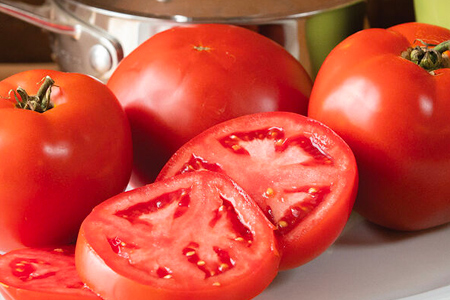
INDETERMINATE
1 • 'Big Beef' & 'Big Beef Plus'
Widely known for its productivity, with flavor that surpasses most other hybrid beefsteaks, 'Big Beef's exceptional vigor enables it to thrive under stresses that may occur in the high tunnel, such as sudden spikes in temperature or humidity. One of the few tomatoes we carry that features gray leaf spot (GLS) resistance, 'Big Beef' also has high resistance (HR) to Fusarium (F). Designated an All America Selection in 1994.
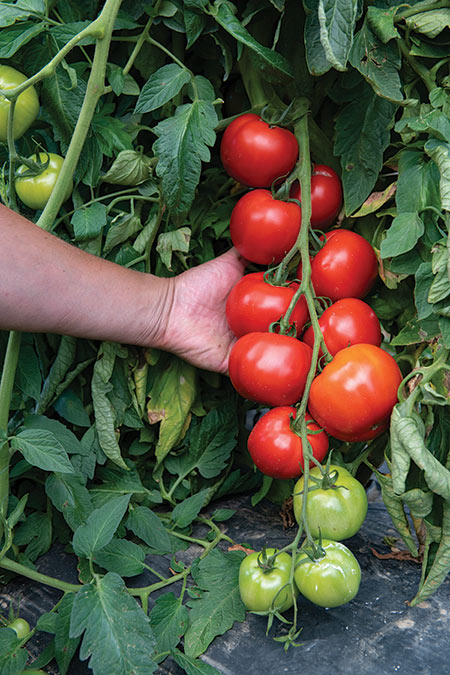
And now, there is 'Big Beef Plus', with flavor, color, and adaptability at an even higher amplitude, combined with a disease resistance package that includes high resistance (HR) to Alternaria stem canker (AS), Fusarium wilt (F) races 1 and 2, Fusarium crown and root rot (FOR), gray leaf spot (GLS), tomato mosaic virus (ToMV), and Verticillium wilt (V); plus intermediate resistance (IR) to tomato spotted wilt virus (TSWV) and nematodes (N).
2 • 'Estiva'
This variety produces beautiful red fruit in a very versatile, 6–7-ounce size. Highly productive even in hot weather, 'Estiva' is sometimes compared to 'Big Beef' in terms of performance, but with slightly smaller fruits. It is a pretty aggressive plant, like 'Early Girl', but puts out a lot of fruit, too, and is less leafy than 'Early Girl'. This balance makes it suited to tunnel production, along with its high resistance (HR) to Fusarium wilt (F) races 1 and 2, tobacco mosaic virus (TMV), and Verticillium wilt (V).
Find out what else makes 'Estiva' one of our 10 Unsung Tomato Heroes…
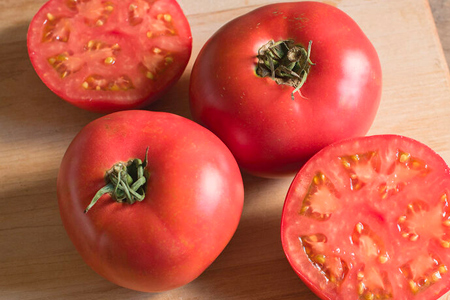
3 • 'Damsel'
The first commercial variety available from independent breeder EarthWork Seeds, 'Damsel' is a popular organic pink variety for growing in tunnels. It has high resistance (HR) to late blight (LB), nematodes (N), and Verticillium wilt (V), but with outstanding, heirloom-like flavor.
DETERMINATE
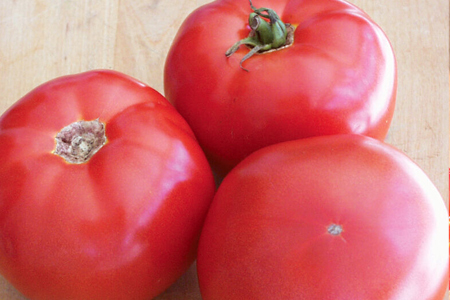
4 • 'BHN 589'
Hands down, 'BHN 589' is the best determinate tomato for the hoophouse. Its plants offer high resistance (HR) to Fusarium wilt (F) races 1 and 2, tobacco mosaic virus (TMV), and Verticillium wilt (V) with high productivity of high-quality fruit. 'BHN 589' also has truly outstanding flavor potential, which is worth noting because it has a very non-delicious name, and also because determinates have a reputation for bland flavor.
Find out why 'BHN 589' is also one of our 10 Unsung Tomato Heroes…
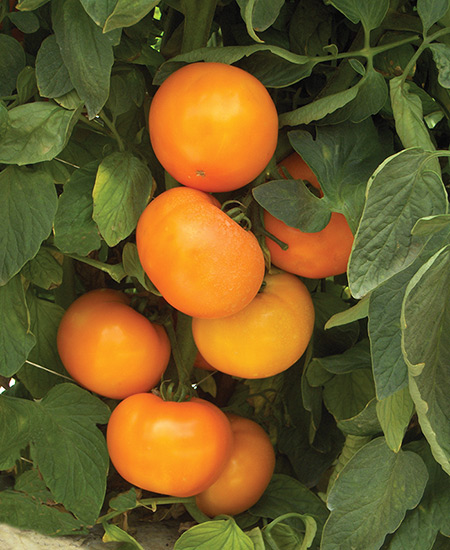
5 • 'BHN 871'
A true-orange variety inside and out, 'BHN 871' is early and high-yielding of 10–12-ounce, flattened-globe-shaped fruits with good flavor. High resistance to Fusarium wilt (F) races 1, 2, Fusarium crown and root rot (FOR), tobacco mosaic virus (TMV), and Verticillium wilt (V).
SMALL-FRUITED
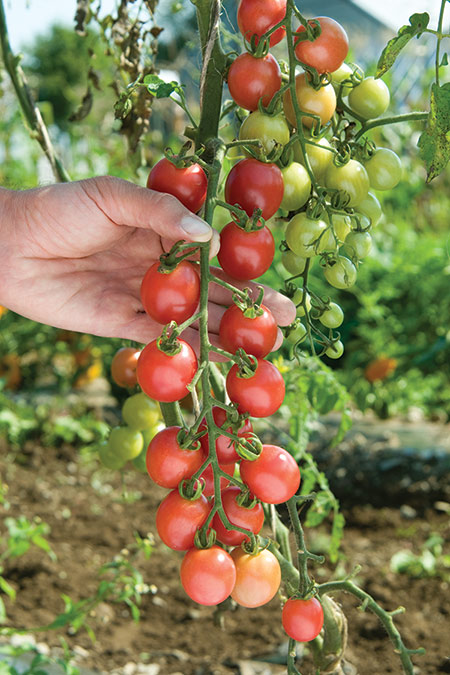
6 • 'Sunpeach'
Pink cherry with high resistance to leaf mold (LM) and tomato mosaic virus (ToMV), 'Sunpeach' has a wonderful low-acid flavor profile typical of pink tomatoes, and rounds out a mixed cherry assortment perfectly. Many Johnny's staff rank this variety in the top-5 for flavor among our tomato offerings. 'Sunpeach' is very productive, too, with above-average fruit size for a cherry — a lot of growers appreciate that because the fruit fill a quart faster. It is also very crack resistant.
Find out why 'Sunpeach' is also one of our 10 Unsung Tomato Heroes…
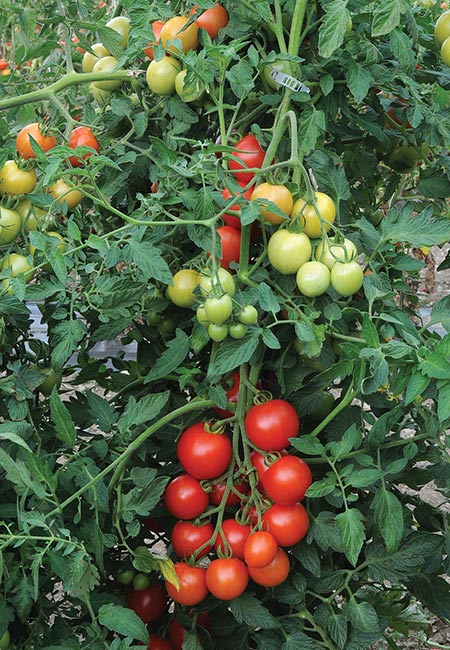
7 • 'Mountain Magic'
This variety checks a lot of boxes, starting with a solid disease resistance package and a bright, sweet flavor. With high resistance (HR) to Fusarium wilt races 1, 2, and 3, late blight (LB), and Verticillium wilt, plus intermediate resistance to early blight (EB), it also offers a high yield potential, crack resistance, and an attractive cocktail size that can be truss-harvested or nicely paired up in a punnet with our own sweet 'Clementine'. 'Mountain Magic' has excellent flavor and better texture than most determinate cherries, plus it's easy to grow.
SPECIALTY
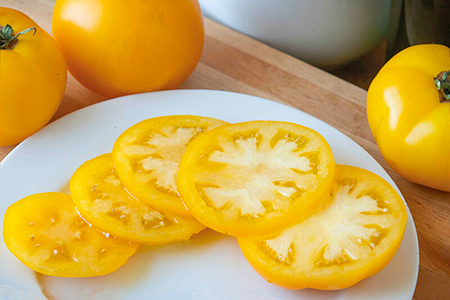
8 • 'Lemon Boy Plus'
A relative new-comer to our assortment, 'Lemon Boy Plus' is an updated version of the classic 'Lemon Boy' tomato with added disease resistance, including high resistance (HR) to Alternaria stem canker (AS), Fusarium crown and root rot (FOR), Fusarium wilt (F) races 1—3, gray leaf spot (GLS), tomato mosaic virus (ToMV), and Verticillium wilt (V), as well as intermediate resistance (IR) to nematodes (N) and leaf mold (LM). It's a high-yielder of notably uniform, high-quality, deliciously tangy sweet fruits of the beefsteak grade, at 7–8 ounces in weight! With its wide adaptability, 'Lemon Boy Plus' excels in diverse production systems, whether greenhouse, tunnel, or field.
PASTE/ROMA
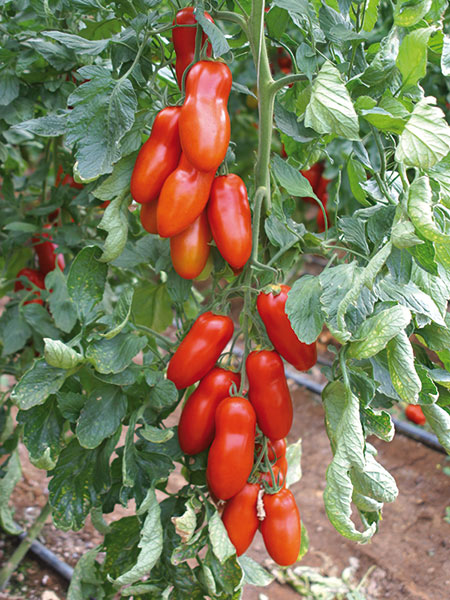
9 • 'Pozzano'
This dual-purpose field/greenhouse selection combines an early and high yield potential with vigorous legs fit for the long run — any way you grow it. 'Pozzano' has high resistance (HR) to Fusarium wilt (F) races 1 and 2, tomato mosaic virus (ToMV), and Verticillium wilt (W). It's got an early and high yield potential, along with Old World, meaty but moist gusto in the cucina.
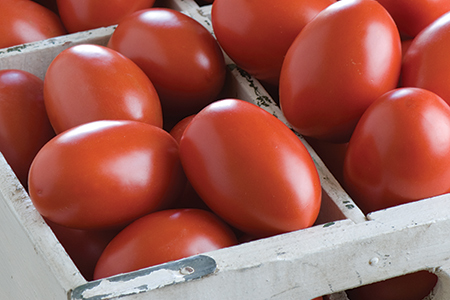
10 • 'Granadero' — A highly productive, organic Roma plum-type, 'Granadero' is one of the few varieties available with resistance to powdery mildew (PM). It also has HR for Fusarium wilt (F) races 1 and 2, tomato mosaic virus (ToMV), and Verticillium wilt (V), as well as intermediate resistance (IR) to nematodes (N) and tomato spotted wilt virus (TSWV), plus low susceptibility to blossom end rot (BER). It produces high yields of highly uniform, thick-walled, richly flavored fruits perfect for tomato pastes, salsas, soups, and sauces.
Extend the tomato season with high tunnels & hoophouses
By providing protection from the elements and maintaining warmer temperatures, high tunnels and hoophouses allow the grower to produce quality fruit at earlier and later harvest dates. At the same time, conditions and disease pressures in tunnels can pose challenges to a tomato crop's success. All the tomatoes we've listed here are good choices — not only due to their disease resistances and growing habit, but also because they deliver excellent yield, appearance, and flavor. Give them a try — and give us a call if you need additional guidance in choosing the best varieties for your particular region and growing methods.


